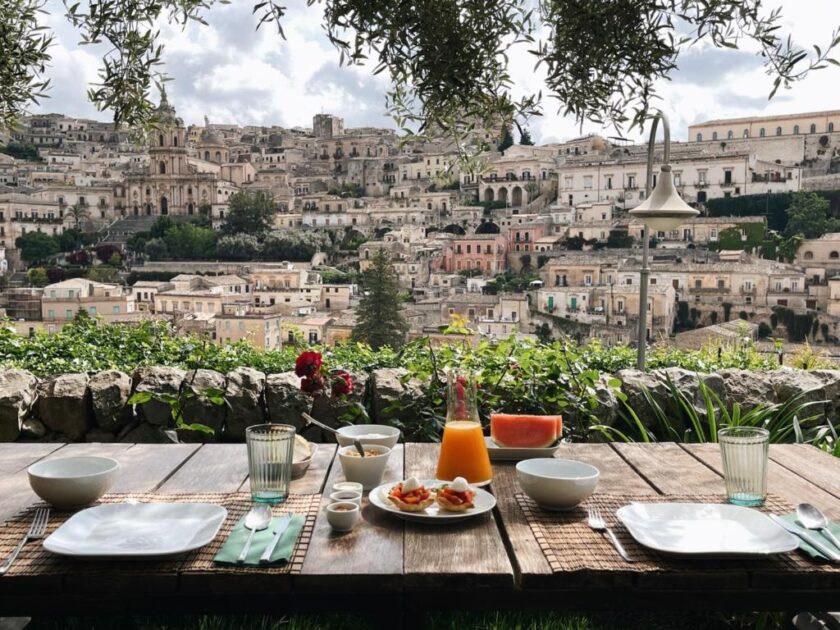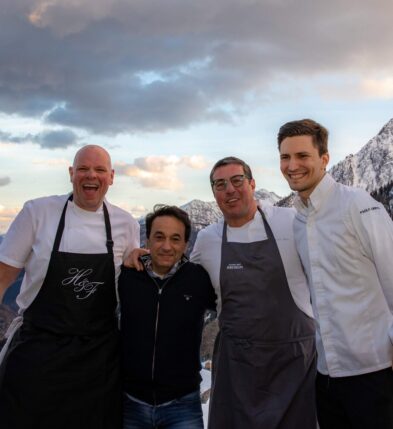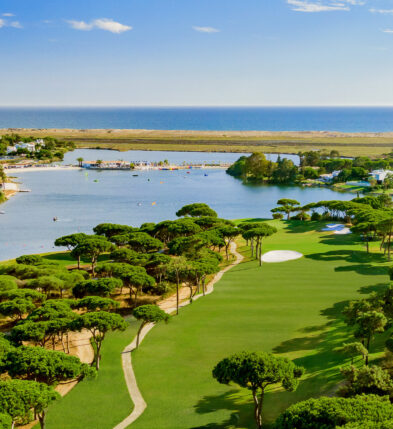Converting a traditional house into a hotel is no easy feat and most certainly isn’t for the faint-hearted. Owner Marko Giunta and his wife Viviana Haddad, took the brave step whilst in Sicily, creating an oasis for slow-living in the traditional baroque city of Modica. In essence, it’s a group of individual houses that make up a stylish and intimate bed & breakfast. Modica is split into two parts, “higher” Modica and “lower” Modica and is known for the 250 steps up to the cathedral of San Giorgio. The way the houses are stacked from low to high is one of the most iconic picture-perfect moments and can be seen from Casa Talía.
What makes Casa Talia different?
— Casa Talía is the result of a dream that we wanted to share with our guests. We found Modica, by chance, back in 2001 while on holiday in Sicily. This was when there were no tourists here; people outside the area didn’t know Modica. There was a real traditional feel here. An original and authentic Sicilian style of life which we fell in love with immediately. We soon decided to purchase a property here, somewhere we could restore ourselves and use it as a summer house. As architects, we could see the potential in the buildings here from a work point of view and the vision to create something of a dream that we could work towards together.
We came across this place while walking in the streets of this quarter. Then, there were no roads leading to this area; it was only accessible by foot. We saw a garden with an opening in the houses that looked out onto the city. Like all the properties around us, it was abandoned. The panoramic view of the magical cityscape of Modica captured us, and we soon purchased this place. We moved to Modica one year later.
When we bought these houses, they were completely abandoned. Only the original rock walls remained. They had no roofs, no electricity or water connections. It took two years of work every day to develop our first three rooms and the garden of Casa Talía. It was a difficult process because there was still no road access. The materials had to be bought here by hand from the main street below.
Initially, our view was to build a summer home here in Modica. This idea soon developed, and we thought to create a unique house for ourselves after purchasing several properties. We wanted to build a property where the garden was the centre of the home, with the separate rooms surrounding, acting as a wall. However, we soon changed ideas and wanted to make something that we could share with others. We needed to keep our same idea on centering the rooms around a unique garden. The fruit gardens are an old Sicilian tradition, although ours was the only one in this quarter, we had to conserve it as it was special. All the rooms backed onto the street, where the original doors had been. When you walk by, our vision was that you look onto the original stone walls, as they have always been. So it didn’t look like part of the original build. We didn’t want something that stood out like a brand new hotel with neon lights. But we did want to create an element of surprise that when you enter through the garden, you have a wonderful sense of discovery when arriving in this lush garden amidst an old and traditional style residential area.

We sourced most of the materials locally. We retrieved the traditional old dry stone to repair the walls from a place in Modica, along with many of the handmade iron furnishings. Many of our tiles are originals; some we had hand-made by local artisans to match. From the beginning, we had the vision to integrate the original structures with some new materials. We felt it necessary to keep the traditional look and feel, so we worked with local artisans to recreate pieces in the classic style. We were the first in this area to use energy-saving lighting and an electric system called Domotic. We use this for the ambient lighting in the gardens that switch off automatically after time and controlling power usage in the rooms so that when guests are out, we automatically turn the power off. We have not used any concrete in our buildings, and many of our materials are recycled.
We want to create an atmosphere where our guests can feel like they are living back in time in the same way as the locals have done for many years – a feeling of slow living. We have large shady trees with seats under the shade where our guests can sit back comfortably while looking at the view of our city, or they can enjoy the privacy of their terrace in their rooms.
Tell us more about Casa Talía’s character
— Casa Talía is a natural, intimate, interior rhythm: just like the character we wanted to give to the structure, taking inspiration from the Arab houses of the Medina, which make a place an oasis of tranquility while remaining in the heart of a town.
Similar to a Moroccan riad, the individual rooms or dwellings (which today have risen to ten, we have built one a year), we didn’t want them to communicate with each other. Instead, they look out onto a central space, the inner garden, a fundamental element of the home and meeting place.
Aware of the fact that building your home in a magical place like Modica means, first of all, respecting the environment and the surrounding area. We have also paid maximum attention to the choice of materials: natural, biocompatible and above all, typical of the Hyblean and Sicilian tradition. From the exposed stone walls to the lime plaster, from the reed roofs to the polychrome ceramic floors, the drywall delimits the garden to the immense white surrounding the cistern, which has become a relaxation and reading room.
The Mediterranean inspires the colours and atmospheres in all the rooms. Like a great lady, everyone courted Sicily, but no one ever possessed her herself.



Having realized our first dream, together with Viviana, we realized that it would not be enough. Therefore, we understood that we neded to share all the beauty of this city and the territory with our guests, along with the special welcome we received over the years from citizens, neighbours, older people from the neighbourhood, friends. Thus, while in all the rooms of Casa Talía we have tried to bring an air (cultural and emotional) of Mediterranean style, we have also worked to make sure that in our garden it was mainly people who met. With their stories of life, their language, their expectations, and their curiosity.
And today, especially during the ritual (word as ever) of breakfast, to those who arrive (from the east or the west, from the north or the south), the map is unveiled to discover and live Modica fully: the walks to do, the rituals in which to participate, the dishes to be tasted, the stops to be enjoyed, the wine to be savoured, the chocolate to be tasted, the places to attend, the corners to be photographed, the crafts to buy, the glimpses of impressing in the heart, the times for walking and those for resting, the fish to eat and the beaches to discover. A sort of reticular sensory journey of Modican excellence. Today more than ever, it is not the luxury of the rooms or the services in which to spend a holiday that makes an exclusive place, but rather the emotions, stories, and experiences that a place allows you to live.
A path to take slowly. Only in this way, little by little discovering the roots of the county’s traditions, one can get used to the low rhythm of an incomparable land, kissed by the Mediterranean sun. Because – just as it happened to me at the beginning of the millennium – you can find beauty: losing yourself in it and finding yourself again.
Do you have any sustainable or eco practices we can share with our readers?
— There are many things that can be done.
• Walk in the Natural Reserve of the Erminio River walking to the sea
• Walk through the dunes of Sampieri beach
• Fast Running UP and DOWN through the alleys of the historic centre
• Visit CAVA d’ISPICA to admire the caves of thousands of years ago
• Visit the farm where the Ricotta is produced






